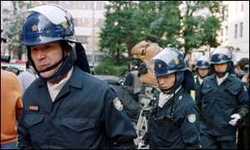Japanese Riot police
Within their security divisions, each prefectural level police department and the Tokyo police maintain Kidotai, special riot units. These units were formed after riots at the Imperial Palace in 1952, to respond quickly and effectively to large public disturbances. They are also used in crowd control during festival periods, at times of natural disaster, and to reinforce regular police when necessary. Full-time riot police can also be augmented by regular police trained in riot duties. Currently, there are 10,000 in the whole riot force.

In handling demonstrations and violent disturbances, riot units are deployed en masse, military style. It is common practice for files of riot police to line streets through which demonstrations pass. If demonstrators grow disorderly or deviate from officially sanctioned areas, riot police stand shoulder-to- shoulder, sometimes three and four deep, to push with their hands to control the crowds. Individual action is forbidden. Three-person units sometimes perform reconnaissance duties, but more often operations are carried out by squads of nine to eleven, platoons of twenty-seven to thirty-three, and companies of eighty to one hundred. Front ranks are trained to open to allow passage of special squads to rescue captured police or to engage in tear gas assaults. Each person wears a radio with an earpiece to hear commands given simultaneously to the formation.
The riot police are committed to using disciplined, nonlethal force and carry no firearms. They are trained to take pride in their poise under stress. Demonstrators also are usually restrained. Police brutality is rarely an issue. When excesses occur, the perpetrator is disciplined and sometimes transferred from the force if considered unable to keep his temper.
Extensive experience in quelling violent disorders led to the development of special uniforms and equipment for the riot police units. Riot dress consists of a field-type jacket, which covered several pieces of body armor and includes a corselet hung from the waist, an aluminum plate down the spine, and shoulder pads. Armored gauntlets cover the hands and forearms. Helmets have faceplates and flared padded skirts down the back to protect the neck. In case of violence, the front ranks carry 1.2-meter shields to protect against staves and rocks and hold nets on high poles to catch flying objects. Specially designed equipment includes water cannons, armored vans, and mobile tunnels for protected entry into seized buildings.
Because riot police duties require special group action, units are maintained in virtually self-sufficient compounds and trained to work as a coordinated force. The overwhelming majority of officers are bachelors who live in dormitories within riot police compounds. Training is constant and focuses on physical conditioning, mock battles, and tactical problems. A military atmosphere prevails—dress codes, behavior standards, and rank differentiations are more strictly adhered to than in the regular police. Esprit de corps is inculcated with regular ceremonies and institutionalization of rituals such as applauding personnel dispatched to or returning from assignments and formally welcoming senior officers to the mess hall at all meals.
Riot duty is not popular because it entails special sacrifices and much boredom in between irregularly spaced actions. Although many police are assigned riot duty, only a few are volunteers. For many personnel, riot duty serves as a stepping stone because of its reputation and the opportunities it presents to study for the advanced police examinations necessary for promotion. Because riot duties demands physical fitness—the armored uniform weighed 6.6 kilograms—most personnel are young, often serving in the units after an initial assignment in a koban.
Special police
In addition to regular police officers, there are several thousand officials attached to various agencies who perform special duties relating to public safety. They are responsible for such matters as railroad security, forest preservation, narcotics control, fishery inspection, and enforcement of regulations on maritime, labor, and mine safety.
The largest and most important of these ministry-supervised public safety agencies is the Japan Coast Guard, an external agency of the Ministry of Land, Infrastructure and Transport that deals with crime in coastal waters and maintains facilities for safeguarding navigation. The agency operates a fleet of patrol and rescue craft in addition to a few aircraft used primarily for anti-smuggling patrols and rescue activities. In 1990 there were 2,846 incidents in and on the waters. In those incidents, 1,479 people drowned or were lost and 1,347 people were rescued.
There are other agencies having limited public safety functions. These agencies include the Labor Standards Inspection Office of the Ministry of Labor, railroad police of Japan Railways Group, immigration agents of the Ministry of Justice, postal inspectors of the Ministry of Posts and Telecommunications, and revenue inspectors in the Ministry of Finance.
A small intelligence agency, the Public Security Intelligence Agency of the Ministry of Justice, handles national security matters both inside and outside the country. Its activities are not generally known to the public.
Source: http://en.wikipedia.org



